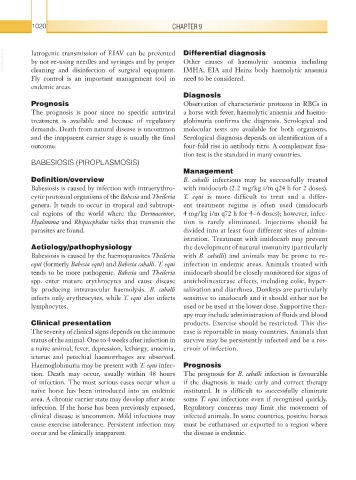Page 1045 - Equine Clinical Medicine, Surgery and Reproduction, 2nd Edition
P. 1045
1020 CHAPTER 9
VetBooks.ir Iatrogenic transmission of EIAV can be prevented Differential diagnosis
Other causes of haemolytic anaemia including
by not re-using needles and syringes and by proper
cleaning and disinfection of surgical equipment.
Fly control is an important management tool in IMHA, EIA and Heinz body haemolytic anaemia
need to be considered.
endemic areas.
Diagnosis
Prognosis Observation of characteristic protozoa in RBCs in
The prognosis is poor since no specific antiviral a horse with fever, haemolytic anaemia and haemo-
treatment is available and because of regulatory globinuria confirms the diagnosis. Serological and
demands. Death from natural disease is uncommon molecular tests are available for both organisms.
and the inapparent carrier stage is usually the final Serological diagnosis depends on identification of a
outcome. four-fold rise in antibody titre. A complement fixa-
tion test is the standard in many countries.
BABESIOSIS (PIROPLASMOSIS)
Management
Definition/overview B. caballi infections may be successfully treated
Babesiosis is caused by infection with intraerythro- with imidocarb (2.2 mg/kg i/m q24 h for 2 doses).
cytic protozoal organisms of the Babesia and Theileria T. equi is more difficult to treat and a differ-
genera. It tends to occur in tropical and subtropi- ent treatment regime is often used (imidocarb
cal regions of the world where the Dermacentor, 4 mg/kg i/m q72 h for 4–6 doses); however, infec-
Hyalomma and Rhipicephalus ticks that transmit the tion is rarely eliminated. Injections should be
parasites are found. divided into at least four different sites of admin-
istration. Treatment with imidocarb may prevent
Aetiology/pathophysiology the development of natural immunity (particularly
Babesiosis is caused by the haemoparasites Theileria with B. caballi) and animals may be prone to re-
equi (formerly Babesia equi) and Babesia caballi. T. equi infection in endemic areas. Animals treated with
tends to be more pathogenic. Babesia and Theileria imidocarb should be closely monitored for signs of
spp. enter mature erythrocytes and cause disease anticholinesterase effects, including colic, hyper-
by producing intravascular haemolysis. B. caballi salivation and diarrhoea. Donkeys are particularly
infects only erythrocytes, while T. equi also infects sensitive to imidocarb and it should either not be
lymphocytes. used or be used at the lower dose. Supportive ther-
apy may include administration of fluids and blood
Clinical presentation products. Exercise should be restricted. This dis-
The severity of clinical signs depends on the immune ease is reportable in many countries. Animals that
status of the animal. One to 4 weeks after infection in survive may be persistently infected and be a res-
a naïve animal, fever, depression, lethargy, anaemia, ervoir of infection.
icterus and petechial haemorrhages are observed.
Haemoglobinuria may be present with T. equi infec- Prognosis
tion. Death may occur, usually within 48 hours The prognosis for B. caballi infection is favourable
of infection. The most serious cases occur when a if the diagnosis is made early and correct therapy
naïve horse has been introduced into an endemic instituted. It is difficult to successfully eliminate
area. A chronic carrier state may develop after acute some T. equi infections even if recognised quickly.
infection. If the horse has been previously exposed, Regulatory concerns may limit the movement of
clinical disease is uncommon. Mild infections may infected animals. In some countries, positive horses
cause exercise intolerance. Persistent infection may must be euthanased or exported to a region where
occur and be clinically inapparent. the disease is endemic.

